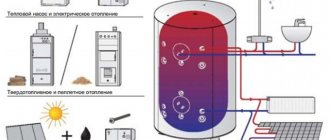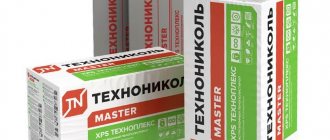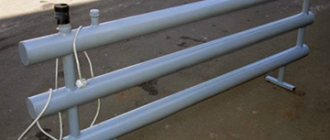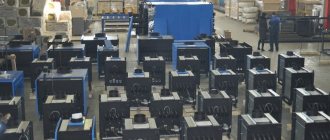How to heat a house if there is no gas
If there is no gas in the house, then heating can be built using solid fuel or electricity, or better yet, a combination of both.
The more diverse the heating sources, the less likely it is that the system will fail. For example, the installation of a solid fuel boiler can be supplemented with an electric convector for each room. You can combine a Russian stove on the first floor of the house and infrared heaters on the second floor. However, electric and solid fuel energy sources are not the whole list. So, let's start in order...
Classic stove heating
In certain cases, a stove is the only possible way to organize heat in the house
Stove heating is considered the oldest. Stove heating is still often used in suburban buildings. Don't think that this method is outdated. The lack of gas in some regions leaves this type of heating still very popular and in demand. Combination stoves remain in fashion, allowing both heating a room and cooking food. Among the advantages of this option are savings on installation, operation, fuel, and versatility. With all this, stoves need to be heated several times a day; they require constant maintenance. In addition, the risk of fire is high; ovens are quite large and take up a lot of space. The room in which the stove is located is always contaminated with soot and coal, and will also require constant cleaning and regular maintenance. There is a high risk of carbon monoxide poisoning if the stove is used incorrectly.
Solid fuel boilers
To heat a house without gas or electricity, you should think about the energy of burning solid fuels:
- brick kilns;
- metal furnaces;
- solid fuel boilers.
There are also fireplaces, but it is difficult to classify them as a home heating system, since they can only be used to heat one room.
Boiler operating conditions
The main models of solid fuel boilers are designed in such a way that the air flow that ensures combustion is directed by a mechanical thermostat with a chain drive. In this case, natural draft of the chimney must be ensured. However, for normal operation of the boiler, a number of conditions must be met:
- Place the pipe so that it is no higher than the incoming pipe.
- Provide the system with free communication with the external environment using an open expansion tank located at the top.
- Create a pipe system with optimal diameters and a minimum number of dead-end branches.
- Equip the boiler with fire safety equipment.
Price
The cost of solid fuel boilers varies in a very wide range - from 20 to 300-400 thousand rubles. It all depends on the design and capacity.
However, despite the price, solid fuel boilers are the best sellers among home heating equipment without gas or electricity.
Heating system options
The most common way to obtain thermal energy is through the combustion of fuel.
In multi-storey buildings, heating is most often central, but there is a massive trend towards switching to an autonomous type of heating. It is several times cheaper and better quality. Nowadays there are compact heaters on sale that can be installed in small apartment kitchens. Practice shows their efficiency and ease of use.
In private houses and cottages, heating can be different:
- Steam from the central boiler room. Nowadays this is rare, mainly in houses that were once departmental, and then became private property. Therefore, central heating is more relevant to multi-apartment high-rise buildings.
- Autonomous on natural gas or electricity. Basically, they try to supply natural gas to houses and dachas wherever there is access to it. Connecting to gas pipeline networks is not difficult if you take into account all the requirements of the gas supply organization and purchase equipment that complies with the rules for installing a gas heating system. Autonomous heating with electricity is quite expensive and is justified only in young regions and in places where it is impossible to connect to gas.
- Stove or fireplace for various types of fuel. If the stove is made by a competent stove maker, then such a heating system solves the problem of how to heat a house without electricity and gas. The stove creates a special microclimate in the house, purifies the air, and living heat has a beneficial effect on the body.
Water circuits are often connected to stoves or fireplaces when it is necessary to organize an effective heating system for a dacha without gas or electricity.
Liquid fuel boiler
The difference between a liquid fuel boiler and a solid fuel boiler is insignificant. To obtain thermal energy, liquid fuel is poured into a liquid fuel boiler instead of coal:
- diesel fuel;
- fuel oil;
- kerosene;
- vegetable oils;
- alcohol.
The last two are provided only as an illustration of the possibilities. The use of oil and alcohol is an unaffordable luxury. And the point is not even that alcohol, for example, is very expensive, but that this fuel is obtained from plant raw materials, which could be used to produce food.
Peculiarities
A distinctive feature of liquid fuel boilers is their high efficiency - up to 92%. In addition, for installation and operation, permission from special services is not required, unlike, for example, gas boilers.
Price
The price range for such boilers ranges from 25,000 to 180,000 rubles and depends on the manufacturer and the volume of the combustion chamber. The average annual cost of heating a private house is 150 sq.m. without gas and electricity on diesel fuel about 150,000 rubles.
Which is higher than the cost of solid fuel and even electricity.
Choice of energy carrier
There is an inverse relationship between the efficiency of heating and the cost of equipment: the more expensive it is to purchase, the cheaper it will be to operate.
What is the most economical heating in a private house? There is no universal answer to this question.
In forests, the cheapest fuel may be firewood; in areas of coal or peat mining, coal or peat, respectively.
In some places it is possible to connect gas, but in others it is not. The most economical electric heating is expensive in any case, but there are options to choose from. To heat houses the following are used:
- gas boilers and convectors;
- solid fuel - firewood, pellets, coal, peat, briquettes, wood and crop waste;
- liquid fuel;
- electric boilers. other electrical appliances;
- heat pumps. We will not consider this option: installation of the system is very expensive, it pays off in 10 years;
- solar panels and collectors. The installation is not justified: batteries collect little energy on winter and cloudy days.
Purchasing a diesel boiler is justified when the household is large (for example, a farm) and the owners have access to cheap fuel. Diesel boilers are produced only with high power; these are not required for a medium-sized house.
But the equipment has many disadvantages: environmental damage, noisy operation, large dimensions and weight, fire hazard. The compact modification of the liquid fuel unit—the exhaust boiler—is also environmentally harmful and fire hazardous. It is low-power, but it is not installed in the house, only in utility buildings.
Another option on how to save on heating a private home: purchase a combination boiler for two or more types of fuel. When purchased, it will cost more than any other.
But, firstly, under no circumstances will you be left without heating: in the absence of one energy source, you will switch to another. Secondly, there is room for savings. For example, expensive electricity can be burned only at “cheap” night time (with two-tariff payment), and during the day it can be heated with wood or coal.
Solar heating
It is possible to convert solar energy into thermal energy only if the sun shines frequently and for a long time over the roof of your house. Unfortunately, 80% of Russian territories have nothing to do with this. However, even in warm climates you cannot rely solely on solar heating; a backup source is definitely needed.
Principle of operation
Light-absorbing batteries are installed in place “under the sun,” which process solar energy directly into thermal energy and then transfer it to the coolant. There are two types of solar collectors - vacuum and flat. Vacuum ones are considered the most efficient and economical. Using solar energy is an achievement of science.
Price
The advantage of solar heating is the low price of solar collectors. Flat devices can be purchased at prices ranging from 1,500 to 60,000 rubles. Vacuum ones are much more expensive - about 80,000 rubles. However, if you consider that you don’t have to pay for fuel, the price is quite reasonable.
Convectors and warm baseboards
The convector is also not the cheapest model, since everything depends on electricity, and energy prices are quite high.
Recently, the warm baseboard system has proven itself well, which replaced stationary radiators and works on the principle of heating a coolant liquid, which creates a heat shield around the perimeter of all rooms. This is practically the most economical home heating, which also has a beneficial effect on health, prevents the appearance of dampness and condensation, and also saves heating.
Thanks for the info. Useful, educational. I will definitely give up fuel oil.
Good afternoon Oleg. It's rare to see such constructive feedback. It is immediately clear that you have actually studied this issue for a long time and painfully. Having read everything to the end, I want to share my work with you. Just like you, I came to exactly the same heating scheme. BUT. Having sat down and considered the benefits of the night tariff for electricity, and the fact that we are mostly at work during the day and turn down the heating, I decided that I would order a heat accumulator for 3m3. Yes, it will take up some space, and the coolant, if not water, will not be cheap. But after calculating the effect of such an idea, I came to the conclusion that this is just it. I won’t describe the operating principle; you will figure it out yourself.
Biofuel use
Biological fuel is any organic matter that can burn. However, this term has recently come to mean the use of gases released by rotting organic matter.
Principle of operation
Anything that rots with sufficient intensity is suitable as a source of such gas. Typically, manure, food waste, and plant matter are used. All gases formed during the decay process burn well and replace natural gas.
The biofuel heating installation itself consists of units that collect the emitted gas, purify it and feed it into boilers for combustion. And then the operating principle is the same as that of a natural gas boiler.
Minuses
A significant disadvantage of this heating method is the low rotting performance under natural conditions. In order to speed up this process, you need to increase the temperature, which costs energy.
For this reason, it is impossible to use biofuel as the main method of heating a large house, but heating a small house or creating an auxiliary system is quite possible.
Biofuel heating is widely used by farms in countries such as Greece, Spain, and Portugal.
Biogas as an alternative to electricity
With the help of special installations for processing waste, it is possible to obtain fertilizer and biogas literally from garbage.
The following wastes are used:
- manure;
- contents of cesspools;
- plant tops;
- weeds;
- silage;
- foliage;
- missing fruits and vegetables and other agricultural waste.
In the future, biogas is used at the discretion of the installation owner. For example, compact power plants running on biogas are sold.
Small biogas plants for the home are able to provide the farmstead with the necessary amount of heat, even if there are only a few heads of cattle, as well as food waste from their site.
From 1 ton of manure you can get 40 m3 of gas. 1 m3 of biogas costs - 3.6 rubles.
Where to buy a biogas plant
For example, companies:
- LLC Investprom from Stary Oskol produces all kinds of construction equipment, mini-factories, including modular bioreactors. Volume from 10 m3 or more (automatic pumping and biogas purification system). Contact number.
- Archey LLC, a company from Rostov-on-Don, offers modular bioreactors for processing animal waste (poultry farms, pigsties, etc.) +7 (863) 2947988.
- And BPC Engineering LLC from Moscow offers mini power plants running on biogas. Phone +7 (495) 7803165.
Heat pumps
Such heat is extracted from nothing, just from the air. This is an air conditioner in reverse. The pump itself does not produce heat, it only extracts it from the medium and sends it in the desired direction.
Operating principle
The principle of operation of the pump is to take heat from the environment in which it is placed. However, the pump needs starting energy. For example, in order to move 10 kW of thermal energy, it needs to consume about 3 kW of electricity.
The difference is impressive! And if electricity is available, it allows you to choose a heat pump for economical heating of a private house without gas.
Features and prices
However, the problem is that in severe frosts such a pump malfunctions. Works well in frosts down to −15, stops working at −30. There is one more drawback - with practically free energy, the pump itself is very expensive - from 200,000 to 1,500,000 rubles.
Design and operation
The heat pump consists of tubes filled with freon, as well as several chambers, namely a heat exchanger, a throttle chamber and a compressor. This device will work similarly to a refrigerator. The operating principle is based on liquid freon, which passes through tubes lowered into the ground or reservoir. There in winter the temperature does not drop below plus 8 degrees. Under such conditions, freon begins to boil; for this it needs only 3 degrees of heat.
Rising upward, the substance, which becomes gaseous, enters the compressor chamber, where it is significantly compressed. As you know, if you compress any substance in a limited space, this leads to an increase in its temperature, so freon heats up to 80 degrees.
Giving off the generated heat through the heat exchanger of the heating system, the mass passes into the throttle chamber, where the temperature and pressure drop, thereby turning freon into liquid. At the next stage, it goes into the depths to warm up and repeat the cycle again.
Still don’t know how to cheaply heat a house without gas? You can use this rather effective technology, the implementation of which will undoubtedly require electricity. However, it will be consumed in disproportionately smaller quantities compared to direct heating of the coolant.
Metal furnaces
Once upon a time they were called potbelly stoves. This name dates back to the distant times of the civil war and subsequent devastation, when the simplest joys of life were associated with great wealth.
Much has changed since then, but an iron stove is still called a potbelly stove. They look different now. Many of them are equipped with fireproof glass windows, but their essence has not changed - they heat up quickly and cool down just as quickly.
Maybe that’s why this stove was called a potbelly stove, because maintaining a constantly high temperature requires a lot of wood, bourgeois style.
Folk fantasy
In the Siberian taiga huts, where it is possible to install a cast-iron stove, but it is difficult to deliver bricks, the potbelly stove is lined on three sides with large stones, rolled in by the river. It turns out beautiful and functional - the stones heat up and slowly release heat to the air.
This technique is quite applicable in the conditions of a country house - when the house is built, but the heating is not yet ready. To some extent, stones perform fire-fighting functions, absorbing random sparks and excess heat. Stone structures can serve as a reason for the designer’s flights of fancy.
The efficiency of a metal stove will increase if you equip it with a coil for heating water and connect heating batteries to it.
Method 1 - electric convectors
With the help of electric convectors it is possible to provide a cheap and efficient heating system. The electric convector is built on the principle of natural air circulation. Warm air moves upward from the heater, thus stimulating the movement of air inside the room and ensuring uniform heating. However, a convector is effective only in warm climates, when the temperature does not fall below 10-15 degrees.
pros
- No forced air blowing. Even in the cleanest home there are particulates that lie on surfaces. When warm air is artificially blown out of a heater, this dust becomes part of the air we breathe. Natural air circulation is not so active, so dust does not rise into the air.
- Small size with sufficient power. The heating elements of convectors heat up quickly, converting electricity into heat with an efficiency of up to 80%. In addition, there is a system of operation in different modes, as well as thermostats that allow operation not constantly, but only when the air temperature drops.
- Mobility, allowing you to move the convector around the room, to places with maximum cold flow.
- The possibility of creating a heating system exclusively using convectors or using them as part of a more complex heating system.
- The electric heating element does not heat up more than 100 degrees, and the body - 60 degrees. They have an increased level of protection from moisture, which allows the convector to be used in the kitchen and bathrooms.
Minuses
- The disadvantage of electric convectors is the installation of heaters in every room of the house.
- In addition, if you turn them on at the same time, there is a possibility of exceeding the permissible power limits.
The photo shows an electric convector from Nobo, Norway
Brick stoves or Russian stoves
In its classic form, the Russian stove is a miracle of engineering soap with a very efficient heating system. Not only did the stove heat the entire hut, it was also a multifunctional kitchen, a heated bed and even a bathhouse.
Nowadays, a number of functions of the Russian stove are not needed, but as heating in a private house without gas and electricity, it is effective!
In modern conditions
Making an ancient Russian stove modern is quite simple:
- If one of the sides is built into the wall separating one room from another, then two rooms will be heated. However, the stove has four sides.
- If you manage to build a stove into two walls of two different rooms, then you can heat almost the entire house.
- If the house is large, then you cannot do it with just one heat source - you will have to make a system of pipes and batteries with a water heating element.
A Russian stove differs from a simple brick stove in its size and the absence of a stove bench. A brick oven has great inertia - it takes a long time to heat up, but it also takes a long time to cool down.
To make the cooling process last longer, there is a damper system that retains hot air. However, it is in this system that the biggest danger of the stove lies - if the damper is closed ahead of time, then carbon monoxide from the firebox will not go into the chimney, but into the house.
Price
The cost of building a brick stove depends on a number of factors: firstly, on the size, secondly, on the selected materials, and thirdly, on the wages of the stove maker. Moreover, the work costs the most.
So, if the stove maker charges moderately, and you are not going to decorate the stove with marble and ceramics, then you can spend 20-60 thousand rubles. Whether it is expensive or not - everyone evaluates it differently. However, you should take into account the fact that the stove will last for decades.
Electricity is a worthy replacement for gas due to its absence
Economical, efficient heating of a private home or cottage without gas should be more focused on maintaining familiar living conditions. The level of comfort determines the choice of an alternative heating method, and today’s technology provides ample room for maneuver. The availability of electricity will allow you to achieve gas savings in the cold season. It is not without reason that many owners of country houses and country cottages, due to the lack of technical capabilities for connecting to the gas main, prefer electric heating systems.
Compared to other heating devices, electric heating devices have almost 100% efficiency. An electric boiler is easy to maintain and inexpensive. In this case, there is no need for exhaust hood and chimney equipment
Electricity remains the most affordable alternative to gas heating today, taking into account efficiency and ease of maintenance
In addition to installing an electric boiler for a water heating system in a house, convectors, heat guns and infrared emitters are actively used to heat small residential buildings. The installation of heated floors in a private home is becoming a fashionable phenomenon today. The technology is quite new, however, it has already proven its effectiveness. The variety of heat sources offered gives you the opportunity to make a choice as to how best to heat your home.
In the event that a heated floor is your main source of heating residential premises, the power of the equipment should be 150-180 W per m2 of living space. Warm floors must have an area of at least 70-80% of the total area of the building itself. Otherwise, the expected heating effect will be negligible.
When heating a private home using other methods, you can achieve even higher economic indicators. Without gas, an economical and uninterrupted source of thermal energy in your area can be obtained using a heat pump. The operating principle of the equipment is based on the difference in temperature, deep in the soil and on the surface. With the help of a heat pump, which really costs a lot of money, you can provide yourself with an almost eternal source of heat in a country house. The effectiveness of this system is confirmed by simple calculations. An indicator of the successful operation of a heat pump is the heat conversion coefficient (COR).
Eg. When a heat pump consumes 1 kW of electricity necessary to ensure the operation of the entire system (Htn), the heat conversion coefficient (COP) is 3.0, which means:
Rtn x COP = 3 kW Rp energy output. The savings and efficiency of this heating method are more than obvious.
There is no clear answer to the question whether it is more profitable to heat a private house with gas or other types of fuel. In each individual case, the presence of a variety of factors plays a role, not least of which are the economic and technical capabilities of the consumer.
Instead of gas for heating, you can use almost any fuel. Another thing is how well you can fully heat your own home in cold weather and create comfortable living conditions for yourself. When faced with a situation like this, the choice is yours. How to save money and make your heating costs optimal depends on you, on your attitude to the very fact of saving energy and technical capabilities.
- Design and calculation of a brick fireplace with your own hands
- How to lay and insulate heating pipes in the ground?
- Why do you need a plinth for heating pipes?
- Selecting ribbed registers, radiators and heating pipes
- How to hide a heating pipe?
How to light the stove
You can drown anything that burns. The classic option is wood and coal. However, the following sources of thermal energy have also been used in the furnace at all times.
Dung
Dung is completely dried cow dung. It burns well and leaves almost no ash. Horse manure can be used for the same purpose. By the way, there is no smell from such fuel.
Peat
Peat, or more precisely, peat briquettes. In terms of calorific value, it is somewhere between wood and coal. Briquettes burn in an already heated firebox. This means that you need to first heat the stove with wood, and then add briquettes.
Advantages - peat is environmentally less toxic than coal.
More precisely, the toxicity of peat smoke can be equated to the toxicity of firewood. Only peat produces more ash and smoke. You can only talk about the benefits of using peat if you have the opportunity to buy it at a low price. In all other cases, it is better to use firewood and coal.
Firewood
Firewood is considered to be the cheapest fuel. However, it is not always possible to agree with this statement. Even if a ton of firewood is cheaper than a ton of coal, you need to compare based on the final result.
Wood burns quickly and is not always hot. To maintain a high temperature in the house you need not just a lot of firewood, you need to put it in the firebox all the time.
Coal
It is best to use coke. Coal burns for a long time, and good coked coal is also hot.
If you use black coal with low ash content and high calorific value, then one measure of coal can provide as much heat as 3-5 such measures of firewood. The only argument against coal is its high ash content.
Coal ash is toxic, so there will be a problem with its disposal.
More
There are other firewood substitutes. For example, seed husks or corn cobs. Both burn well, but not for long, and without intense heat. However, these types of fuel should not be considered seriously.
Thus, among all types of solid fuels, it is worth choosing firewood and coal. Moreover, precisely in combination. Firewood is good for lighting the stove, and coal is good for long and slow burning.
Comparison
Operating costs
Here's how our participants line up when assessing their cost-effectiveness:
- The undisputed leader is solar heat. Collectors convert it into heating coolant completely free of charge. Electricity is consumed only by circulation pumps;
Pitched roof with solar collectors.
- In second place is a solid fuel boiler that runs on wood. Yes, yes, I am aware that we are in the 21st century. These are Russian realities: in the absence of main gas and with short daylight hours, firewood is still more economical than all other heat sources and provides a cost per kilowatt-hour of 0.9 - 1.1 rubles;
- Third place is shared by pellets and coal. Depending on local energy prices, a kilowatt-hour of heat obtained by burning them will cost 1.4-1.6 rubles;
- Liquefied gas from a gas tank provides a kilowatt-hour cost of 2.3 rubles;
- The use of cylinders increases it to 2.8 - 3 rubles;
The gas cylinder station will allow you not to change the cylinder every day.
- Liquid fuel boilers running on diesel fuel produce heat with an average cost of about 3.2 rubles/kWh;
- The obvious outsiders are electric boilers. The price of a kilowatt-hour of heat obtained by heating water with a heating element or any other direct heating device is equal to the cost of a kilowatt-hour of electricity and, at current rates, is approximately 4 rubles.
Induction electric boiler. Its undoubted advantage is reliability. But in terms of efficiency, it is no different from a device with heating elements.
Installation costs
How much will it cost to install heating in a country house or country house?
In order not to cause confusion due to the variation in the parameters of the heating system, I will compare the average cost of heat sources of the same rated power - 15 kW.
Gas boiler - from 25 thousand rubles;
- Pellet boiler - from 110,000;
- Electric boiler - from 7000;
- Solid fuel boiler - 20,000;
- Liquid fuel (diesel or exhaust) - from 30,000;
- Solar collectors with a total power of 45 kW (three times the power reserve compensates for downtime in the dark) - from 700,000 rubles.
Downtime at night has to be compensated for by the number of collectors.
Obviously, only wood and coal provide a reasonable balance between the cost of a kilowatt-hour of heat and the heating equipment itself. A good alternative to them - used oil - cannot participate on equal terms in our competition due to the inaccessibility of this energy carrier.
Free solar heat turns out to be prohibitively expensive at the installation stage: the cost of a thermal energy accumulator will be added to the exorbitant costs of the collectors themselves.
Diagram of a heating system with solar collectors.
Ease of use
Laziness, as you know, is the engine of progress. You want to heat your home not only cheaply, but also with minimal expenditure of time and effort.
What are the different heating options with autonomy?
- Electric boilers are in the lead. They work indefinitely and do not require any maintenance at all. The coolant temperature can be adjusted automatically using a remote electronic thermostat. Electrical equipment allows you to program daily and weekly cycles (for example, reduce the temperature while you are away);
Remote thermostat for an electric boiler.
- A gas boiler with a gas tank provides autonomy for several months, or even an entire season. It differs unfavorably from an electric boiler in the need to remove combustion products, so the location of the device is tied to the ventilation, chimney or external walls of a private house;
- The autonomy of a liquid fuel device is limited only by the volume of the fuel tank;
Diesel boiler room.
- The use of several parallel-connected cylinders reduces the autonomy of heating equipment by up to a week;
- A pellet boiler can work approximately the same amount of time on one load;
- A solid fuel boiler needs to be topped up every few hours and the ash pan needs to be periodically cleaned. This period can be increased by limiting the thermal power with a covered air damper, but in this case, incomplete combustion of the fuel will reduce the efficiency of the device and, accordingly, increase the owner’s heating costs.
What's the result? But in the end, comrades, we have to choose between the limited autonomy of a pellet boiler with its rather high cost, the continuous kindling of a solid fuel appliance and the sky-high cost of thermal energy from an electric boiler.
The main problem with solid fuel heating is frequent lighting.
Autonomous gasification: an expensive pleasure
Heating with liquefied gas is exactly the option that needs to be considered in special, exceptional cases: not only is the fuel itself quite expensive, but you will also need to install a massive gas tank, the cost of which depends on its volume; in general, gasification costs can be quite significant.
Heating with liquefied gas will require the installation of a gas holder
You can, of course, use small cylinders for heating, but this is inconvenient for a number of reasons, especially in large houses where people live constantly and not from time to time. Thus, autonomous gas systems cannot be called a popular way of organizing heating.
Types of sealants
Based on their composition, sealants are divided into three types:
- Acrylics are unstable and do not tolerate temperature changes well.
- Polyurethane - characterized by elasticity, good adhesion to metal surfaces, resistance to corrosion and high temperatures.
- Silicone is the most common type of sealant due to its versatility. Moreover, this product retains moisture resistance and elasticity in a fairly wide range of temperature conditions.
- Liquid polymer - used in heating systems specifically to eliminate leaks. They are a liquid that polymerizes upon contact with air.
Below we will take a closer look at the most common types of sealants.
Universal silicone
The most common today is a universal heat-resistant sealant, which is most often used to seal joints. This composition has all the necessary qualities.
In particular, among its properties the following points can be highlighted:
- Good strength;
- The composition is quite liquid and fluid, thanks to which it is able to penetrate even the narrowest crevices;
- Good elasticity.
It must be said that this sealant is used not only for heating systems, but is also used for other household purposes, as well as in industry.
Polyurethane sealant
Polyurethane
A distinctive feature of these compounds is durability and resistance to aggressive environments, as well as mechanical stress. In addition, the advantages include the cost-effectiveness of the composition.
It should be noted that polyurethane sealants come in one- and two-component types. The former take longer to harden, however, their price is lower. It must be said that despite a lot of positive qualities, polyurethane compounds are less common in everyday life than silicone ones, as they are more expensive.
Liquid sealant
Liquid polymer
All of the above compounds are intended for external application to the radiator or processing of threaded connections. But, in some cases, it is impossible to seal a leak from the outside, for example, if it is difficult to detect the damaged area. Then a polymer liquid sealant comes to the rescue.
The principle of its operation is based on the fact that it is poured into the system along with the coolant. In the area where there is a leak, the composition begins to interact with air and polymerize. Thus, clots of the composition seal the gap.
It should be noted that there are several types of liquid sealants:
- For systems operating on water.
- For systems running on antifreeze.
- For sealing metal surfaces.
- For plastic pipes.
Thus, before purchasing the composition, you should read the information contained in the instructions on the package.
Applying sealant to a threaded connection











